Papers by Maria Jose Haro Sly

América do Sul, Latina e Caribe - Por que e como buscar a integração regional , 2023
Este artículo se propone discutir el papel de la ciencia, la tecnología y la innovación (CTI) en ... more Este artículo se propone discutir el papel de la ciencia, la tecnología y la innovación (CTI) en la región haciendo un estudio de caso de la producción de vacunas en Argentina y Brasil teniendo en cuenta el contexto de la biotecnología Latinoamericana. El artículo presentará datos sobre la asimetría en CTI en el Mercado Común del Sur (Mercosur) y comparando la región con las mayores potencias tecnológicas contemporáneas Estados Unidos y China. Se analiza la dependencia tecnológica en el marco de la pandemia de covid-19 en la región y desarrollará los casos de Argentina y Brasil en la producción de vacunas. Finalmente, se propone la necesidad de avanzar con la implementación de una agencia regulatoria de medicamentos del Mercosur procurando la soberanía sanitaria para facilitar la producción de medicamentos, insumos médicos y vacunas en la región.
Data analyzed in the Palgrave Communications article, “The Argentine Portion of the Soybean Commodity Chain”
The Argentine Portion of the Soybean Commodity Chain - datasets
Data analyzed in the Palgrave Communications article, "The Argentine Portion of the Soybean ... more Data analyzed in the Palgrave Communications article, "The Argentine Portion of the Soybean Commodity Chain"
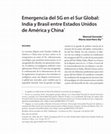
OASIS, 2021
La creciente disputa entre Estados Unidos de América y China tiene un foco crítico en la competen... more La creciente disputa entre Estados Unidos de América y China tiene un foco crítico en la competencia en torno al 5G, infraestructura tecnológica que permitirá innovaciones en el autoguiado de vehículos, las operaciones remotas, la robótica, la inteligencia artificial y otras aplicaciones. Si bien el 5G aún está emergiendo, la conformación de la infraestructura de red, las regulaciones, las patentes y los estándares se configuran como una disputa eminentemente global por mercados, pero también por la seguridad nacional. Esto ha ganado un lugar central en la agenda de política externa de la mayoría de los países del globo, incluyendo a los del Sur Global. En este contexto, el objetivo de este trabajo es analizar las condiciones de emergencia del 5G en dos de los principales países del Sur Global, India y Brasil, en el marco de la disputa entre EE.UU. y China. A través de la contextualización de esta disputa y sus desdoblamientos en India y Brasil se busca extraer una serie de reflexio...

Revista de Gestão, 2021
PurposeIn recent years, the People's Republic of China has made remarkable progress in scienc... more PurposeIn recent years, the People's Republic of China has made remarkable progress in science and technology. The Chinese industry is competing for leadership in cutting-edge technologies such as 5G, robotics, artificial intelligence, aerospace and green energy. This article aims to analyze: What role do industrial parks, especially Suzhou Industrial Park, play in upgrading technology to encourage independent innovation and economic development? How SIP is related to the Belt and Road Initiative?Design/methodology/approachThis research summarizes China's most important scientific and technological reforms and policies and in particular the Torch Program. In addition, it develops a case study of the Suzhou Industrial Park (SIP) by analyzing documents, bibliography and presenting data. It ends with a case study of the role of SIP in the Belt and Road Initiative analyzing the Great Stone Park in Belarus.FindingsThis article highlights that: China's experience clearly shows...
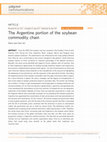
Palgrave Communications, 2017
Since the 1990s the soybean crop has increased in the Southern Cone of Latin America (LA). During... more Since the 1990s the soybean crop has increased in the Southern Cone of Latin America (LA). During this time, Argentina, Brazil, Uruguay, Bolivia and Paraguay have become soybean producers. This phenomenon was influenced by the rising soybean demand from China for use in animal feed as the country changed its diet patterns. South American soybean exports to China constitute an important percentage of the bilateral commerce. Basically, two views can be identified with regard to China's relations with LA countries. One of them emphasizes opportunities for building mutually beneficial relations and underscores the economic complementarity between both regions. Yet, the critical literature on China and Latin American relations draws attention to the contradictions of this process by highlighting the deepening of neo-extractivism and the expansion of the agricultural frontier. Describing the Argentine portion of the soybean commodity chain this paper will present data to support this critical literature. It depicts the actors, strategies and the degree of monopolization of each of the nodes of soybean production based on secondary data. The article's key findings are as follows: (1) there is high monopolization and foreignization of soybean production and commercialization; (2) as China has become a global player in genomics and agrochemicals, it has reproduced the same patterns as the core countries; (3) despite the win-win diplomatic statements of the People's Republic of China, there are important asymmetries in trade, and the Argentine deficits have continually increased; (4) by expanding GM soybean production, Argentina has augmented the concentration of land, primarization and transnationalization of the economy and monoculture; (5) the Cristina F. de Kirchner progressive government failed to stop soybean expansion, and with the drop of the economic growth rate that is associated with the fall of commodity prices combined with the restriction of access to international credits, the government was put in check by various fronts. The distributive conflict contributed to the increasing social confusion that led to a right wing recovery in 2015. Therefore, this article shows that China's increasing trade with Argentina in the soybean sector follows the existing structure of the global commodity chain and does not offer much space for progressive change in Argentina's political economy. The data that are presented demystify Chinese win-win statements and counter expectations about China as an alternative globalizer that would bring more benefits to the global South than traditional core countries have.
Ciencia, tecnología y política, 2021
La República Popular de China pasó en pocas décadas de constituir un país periférico a ser la seg... more La República Popular de China pasó en pocas décadas de constituir un país periférico a ser la segunda potencia económica, científica y tecnológica mundial. Entre otros factores para explicar este rápido ascenso en el escenario global, destacan las decisiones en materia de política científica, tecnológica y de innovación. Este artículo analiza, en primer lugar, el papel que las políticas de ciencia y tecnología tuvieron en la historia reciente china a partir de una periodización en torno a los principales hitos desde la revolución de 1949 hasta la actualidad. En segundo lugar, a partir de la experiencia china, se extraen algunas lecciones que pueden ser relevantes para la formulación de políticas científicas y tecnológicas en el contexto argentino y latinoamericano.
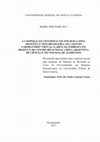
This dissertation aims to assess the extent to which the cooperation in science and technology (S... more This dissertation aims to assess the extent to which the cooperation in science and technology (S&T) between the People's Republic of China (PRC) and the Argentine Republic (RA) and the Federative Republic of Brazil (RFB) has contributed to the development of Science and technology (S&T) and the strengthening of Triple Helix innovation complexes (university, industry, State) in the respective South American countries. The dissertation also seeks to assess to what extent this type of South-South cooperation differs from North-South cooperation. To achieve these objectives, I analyze 185 agreements in S&T cooperation signed by RA and RFB with the PRC and the United States (USA). The agreements analyzed were those signed after the reestablishment of diplomatic relations in the 1970s until 2016 and which appear available on the pages of the Ministries of Foreign Affairs of Argentina and Brazil. In the agreements, the following aspects were identified: areas of interest, investments, joint projects, processes of technology transfer, among others. In addition to the documental analysis, I evaluated the results of two cooperation programs in the agricultural area: EMBRAPA's Virtual Lab-LABEX in Beijing and the Chinese-Argentine Binational Center for Food Science and Technology. In this dissertation, I conclude that there are some differences in the logic of the South-South cooperation with China and the North-South with the USA. However, due to differences in scientific-technological capacities between South American countries and China, S&T cooperation differs only partially from cooperation with the US. On the other hand, the results of cooperation fall far short of expectations of government speeches and official documents about the win-win relation with China.
OASIS. , 2021
La creciente disputa entre Estados Unidos de América y China tiene un foco crítico en la competen... more La creciente disputa entre Estados Unidos de América y China tiene un foco crítico en la competencia en torno al 5G, infraestructura tecnológica que permitirá innovaciones en el autoguiado de vehículos, las operaciones remotas, la robótica, la inteligencia artificial y otras aplicaciones. Si bien el 5G aún está emergiendo, la conformación de la infraestructura de red, las regulaciones, las patentes y los estándares se configuran como una disputa eminentemente global por mercados, pero también por la seguridad nacional. Esto ha ganado un lugar
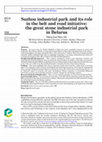
Revista de Gestão, 2021
Purpose-In recent years, the People's Republic of China has made remarkable progress in science a... more Purpose-In recent years, the People's Republic of China has made remarkable progress in science and technology. The Chinese industry is competing for leadership in cutting-edge technologies such as 5G, robotics, artificial intelligence, aerospace and green energy. This article aims to analyze: What role do industrial parks, especially Suzhou Industrial Park, play in upgrading technology to encourage independent innovation and economic development? How SIP is related to the Belt and Road Initiative? Design/methodology/approach-This research summarizes China's most important scientific and technological reforms and policies and in particular the Torch Program. In addition, it develops a case study of the Suzhou Industrial Park (SIP) by analyzing documents, bibliography and presenting data. It ends with a case study of the role of SIP in the Belt and Road Initiative analyzing the Great Stone Park in Belarus. Findings-This article highlights that: China's experience clearly shows that the "visible hand" of the State plays a very important role in economic development and technological catch-up. All of them are implemented from a strategy linking the national objectives with the local ones, this is done from a top-down perspective. As an important aspect of economic and social development, China's experience in promoting indigenous innovation in science and technology provides a relevant example for developing countries. Research limitations/implications-There are few academic literature on Great Stone Industrial Park. Practical implications-The international cooperation of the SIP with the technology parks throughout the BRI-countries provides relevant information to deepen collaboration in this field and could contribute to closing the technological gap in developing countries. Originality/value-The role of the SIP in the Belt and Road initiative is an under research topic. There is few bibliography discussing the impacts of the cooperation in science and technology in the framework of the BRI.
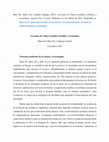
Haro Sly, María José; Liaudat, Santiago (2021). Lecciones de China en política científica y tecno... more Haro Sly, María José; Liaudat, Santiago (2021). Lecciones de China en política científica y tecnológica. Agencia Paco Urondo. Publicado el 9 de febrero de 2021. Disponible en: https://www.agenciapacourondo.com.ar/ciencia-y-tecnologia/lecciones-de-china-en-politica-cientifica-y-tecnologica Lecciones de China en política científica y tecnológica María José Haro Sly y Santiago Liaudat 9 de febrero 2021 Funciones modernas de la ciencia y la tecnología Entre los siglos XV y XIX, con la expansión global de la modernidad y el capitalismo centrados en Europa, se extendió la idea de que la ciencia y la tecnología eran las herramientas fundamentales para alcanzar el progreso. Indudablemente se lograron grandes avances en el conocimiento y manipulación de la naturaleza, permitiendo notables mejoras en materia de salud, alimentación, transporte, confort, comunicaciones, etc. Pero además de estos aspectos positivos, la ciencia y la tecnología se constituyeron como poderosas herramientas de dominación. De hecho, el desarrollo de las metrópolis modernas fue de la mano con la subordinación colonialista de territorios y poblaciones en el resto del mundo. La supremacía científica y tecnológica europea fue una de las claves para alcanzar el dominio mundial, tanto en términos geopolíticos como económicos. La epoya de la emergencia de Occidente trajo aparejado el silenciamiento del resto del mundo. Mucha agua ha corrido bajo el puente desde esa postal de la modernidad. La aceleración de la historia que produjo el capitalismo industrial hace imposible condensar en pocas líneas la cantidad de sucesos que acontecieron desde entonces. Solo a modo ilustrativo podemos enumerar las independencias americanas, el despegue estadounidense y el neocolonialismo financiero y comercial en América Latina; la colonización europea de Asia y África; la irrupción alemana desde la unificación de 1871 y la búsqueda de "espacio vital" que condujo al choque con los viejos imperios en las guerras más brutales que conoció la humanidad; las revoluciones comunistas; el
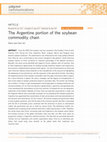
Since the 1990s the soybean crop has increased in the Southern Cone of Latin America (LA). During... more Since the 1990s the soybean crop has increased in the Southern Cone of Latin America (LA). During this time, Argentina, Brazil, Uruguay, Bolivia and Paraguay have become soybean producers. This phenomenon was influenced by the rising soybean demand from China for use in animal feed as the country changed its diet patterns. South American soybean exports to China constitute an important percentage of the bilateral commerce. Basically, two views can be identified with regard to China's relations with LA countries. One of them emphasizes opportunities for building mutually beneficial relations and underscores the economic complementarity between both regions. Yet, the critical literature on China and Latin American relations draws attention to the contradictions of this process by highlighting the deepening of neo-extractivism and the expansion of the agricultural frontier. Describing the Argentine portion of the soybean commodity chain this paper will present data to support this critical literature. It depicts the actors, strategies and the degree of monopolization of each of the nodes of soybean production based on secondary data. The article's key findings are as follows: (1) there is high monopolization and foreignization of soybean production and commercialization; (2) as China has become a global player in genomics and agrochemicals, it has reproduced the same patterns as the core countries; (3) despite the win-win diplomatic statements of the People's Republic of China, there are important asymmetries in trade, and the Argentine deficits have continually increased; (4) by expanding GM soybean production, Argentina has augmented the concentration of land, primarization and transnationalization of the economy and monoculture; (5) the Cristina F. de Kirchner progressive government failed to stop soybean expansion, and with the drop of the economic growth rate that is associated with the fall of commodity prices combined with the restriction of access to international credits, the government was put in check by various fronts. The distributive conflict contributed to the increasing social confusion that led to a right wing recovery in 2015. Therefore, this article shows that China's increasing trade with Argentina in the soybean sector follows the existing structure of the global commodity chain and does not offer much space for progressive change in Argentina's political economy. The data that are presented demystify Chinese win-win statements and counter expectations about China as an alternative glo-balizer that would bring more benefits to the global South than traditional core countries have.
Thesis Chapters by Maria Jose Haro Sly
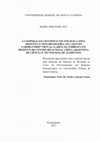
This dissertation aims to assess the extent to which the cooperation in science and technology (S... more This dissertation aims to assess the extent to which the cooperation in science and technology (S&T) between the People's Republic of China (PRC) and the Argentine Republic (RA) and the Federative Republic of Brazil (RFB) has contributed to the development of Science and technology (S&T) and the strengthening of Triple Helix innovation complexes (university, industry, State) in the respective South American countries. The dissertation also seeks to assess to what extent this type of South-South cooperation differs from North-South cooperation. To achieve these objectives, I analyze 185 agreements in S&T cooperation signed by RA and RFB with the PRC and the United States (USA). The agreements analyzed were those signed after the reestablishment of diplomatic relations in the 1970s until 2016 and which appear available on the pages of the Ministries of Foreign Affairs of Argentina and Brazil. In the agreements, the following aspects were identified: areas of interest, investments, joint projects, processes of technology transfer, among others. In addition to the documental analysis, I evaluated the results of two cooperation programs in the agricultural area: EMBRAPA's Virtual Lab-LABEX in Beijing and the Chinese-Argentine Binational Center for Food Science and Technology. In this dissertation, I conclude that there are some differences in the logic of the South-South cooperation with China and the North-South with the USA. However, due to differences in scientific-technological capacities between South American countries and China, S&T cooperation differs only partially from cooperation with the US. On the other hand, the results of cooperation fall far short of expectations of government speeches and official documents about the win-win relation with China.
Key-words: China – Brazil – Argentina – Science and Technology cooperation – Agricultural cooperation.
International political economy by Maria Jose Haro Sly

New Nationalisms and China's Belt and Road Initiative: Exploring the Transnational Public Domain
Palgrave Macmillan, 2022
This book is a treatise on cultural globalization and the global political economy. By introducin... more This book is a treatise on cultural globalization and the global political economy. By introducing the transnational public domain in the study of China’s Belt and Road Initiative (BRI), the book goes beyond existing theoretical frameworks involving both the ‘clash between civilizations’ and the ‘time-worn division’ of the world into North and South. It advances a new focus on the theoretical and empirical elements that canvass global cultural behaviours and reactionary attitudes to the expanding Chinese economic norms, cultures and values in different national contexts.
Readers of political theory, global political economy, globalization, international relations, political sociology, cultural sociology, public policy and foreign policy analysis will find interest in the book. Whereas new nationalism couples with globalism, both concepts are rediscovered through various socio-economic contexts of BRI policy discourses, which produce conflicts, solidarities, new economic partnerships, and cooperation and resistance as types of contemporary nationalism. The new nationalism is approached as a dual-sided, relational, and dialectical phenomenon which readers will capture by paying particular attention to both the global and local scales of the social responses to the BRI.









Uploads
Papers by Maria Jose Haro Sly
Thesis Chapters by Maria Jose Haro Sly
Key-words: China – Brazil – Argentina – Science and Technology cooperation – Agricultural cooperation.
International political economy by Maria Jose Haro Sly
Readers of political theory, global political economy, globalization, international relations, political sociology, cultural sociology, public policy and foreign policy analysis will find interest in the book. Whereas new nationalism couples with globalism, both concepts are rediscovered through various socio-economic contexts of BRI policy discourses, which produce conflicts, solidarities, new economic partnerships, and cooperation and resistance as types of contemporary nationalism. The new nationalism is approached as a dual-sided, relational, and dialectical phenomenon which readers will capture by paying particular attention to both the global and local scales of the social responses to the BRI.
Key-words: China – Brazil – Argentina – Science and Technology cooperation – Agricultural cooperation.
Readers of political theory, global political economy, globalization, international relations, political sociology, cultural sociology, public policy and foreign policy analysis will find interest in the book. Whereas new nationalism couples with globalism, both concepts are rediscovered through various socio-economic contexts of BRI policy discourses, which produce conflicts, solidarities, new economic partnerships, and cooperation and resistance as types of contemporary nationalism. The new nationalism is approached as a dual-sided, relational, and dialectical phenomenon which readers will capture by paying particular attention to both the global and local scales of the social responses to the BRI.